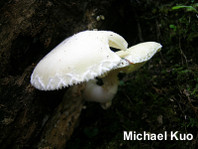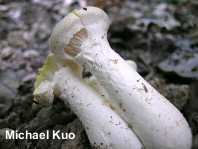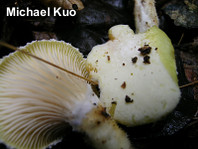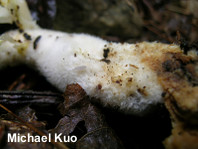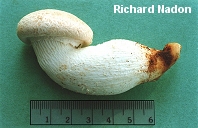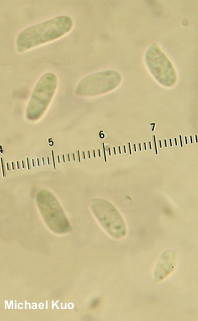| Major Groups > Gilled Mushrooms > Pale-Spored > Pleurotus dryinus |

|
Pleurotus dryinus [ Basidiomycota > Agaricales > Pleurotaceae > Pleurotus . . . ] by Michael Kuo This distinctive Pleurotus has a sturdy, fairly central stem and a partial veil that leaves remnants on the margin of the cap and the stem. It is not at all "pleurotoid," despite belonging to the genus that provides the term. When the partial veil remnants are worn away (which is fairly often), it can usually be separated from similar mushrooms like Hypsizygus ulmarius by its densely fuzzy cap and stem. However, separating Pleurotus dryinus from Pleurotus levis is not an easy task. Although the two species are distinct biologically (meaning they cannot mate in culture), they are hardly different in their physical features. According to Petersen, Hughes & Psurtseva (no date) Pleurotus levis has a "velutinous to plushy" (translation: very finely hairy to finely velvety) cap surface and appears in "warm climates," while Pleurotus dryinus has a "strigose to wooly" (translation: notably hairy) cap and appears in "cool, wet climates." However, specimens with kind-of-hairy cap surfaces abound, and determining the described differences in climate is often futile. Since microscopic features do not help in this case, one would just about have to culture every new collection to be sure of an identification. Description: Ecology: Saprobic; growing alone or in small clusters on dead and living wood of hardwoods (especially oaks and beech); summer and fall (winter in coastal California); widely distributed in North America. The illustrated and described collections are from Missouri, Kentucky, and Québec. Cap: 4–10 cm; convex, becoming broadly convex; circular in outline; hairy; whitish beneath whitish to pale grayish hairs, but often yellowing with age; the margin inrolled when young, hung with partial veil remnants. Gills: Running down the stem; close or nearly distant; whitish, yellowing with age. Stem: 4–8 cm long; 1–2 cm thick; tough; usually a little off-center; the lower portion with a densely fuzzy sheath that terminates in an ephemeral ring; above the ring smooth or with ridges resulting from the gills; whitish, yellowing with age. Flesh: Thick; tough; whitish; yellowing with age. Odor and Taste: Odor not distinctive; taste mild. Chemical Reactions: KOH on cap surface negative. Spore Print: White. Microscopic Features: Spores 9–12 x 3.5–4.5 µm; cylindric; smooth; hyaline in KOH; inamyloid. Basidia 4-steigmate. Hymenial cystidia not found. Pileipellis a tangled cutis; elements 2.5–5 µm wide, smooth, hyaline to yellowish, clamped at septa. REFERENCES: (Persoon, 1800) Kummer, 1871. (Fries, 1821; Saccardo, 1887; Kauffman, 1918; Smith, Smith & Weber, 1979; Weber & Smith, 1985; Arora, 1986; Phillips, 1991/2005; Lincoff, 1992; Metzler & Metzler, 1992; Zervakis & Balis, 1996; Barron, 1999; Roody, 2003; McNeil, 2006; Miller & Miller, 2006; Petersen et al., no date.) Herb. Kuo 10010415. This site contains no information about the edibility or toxicity of mushrooms. |
© MushroomExpert.Com |
|
Cite this page as: Kuo, M. (2018, February). Pleurotus dryinus. Retrieved from the MushroomExpert.Com Web site: http://www.mushroomexpert.com/pleurotus_dryinus.html |
